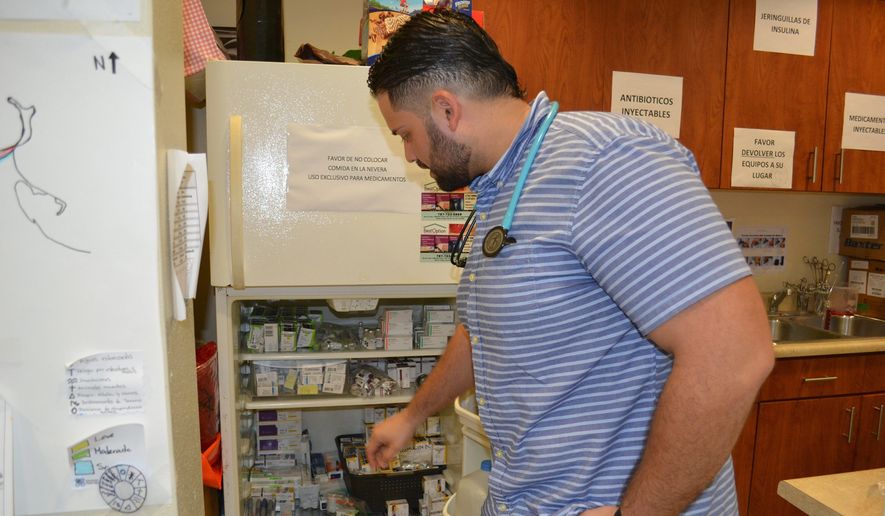
Publish January 7, 2018 | The Washington Times
By Laura Kelly
TOA BAJA, Puerto Rico — Fresh from completing his pediatric residency, Jorge Rosado was tasked with turning a Head Start nursery school into a medical clinic a little less than a week after Hurricane Maria left Puerto Rico in destruction.
“There was already two patients waiting for us here because they had announced the clinic was open,” Dr. Rosadotold The Washington Times in between tending to patients. “There was nothing. There was just that table right there. It had just two empty oxygen tanks, a few gauze and some alcohol pads.”
Nearly 3 months later, Dr. Rosado and a team of dedicated volunteers have turned a space from what was likely a teachers lounge into an organized clinic.
“Although things have been improving, there are still a lot of people that are basically living in a permanent emergency state.”
Two triage areas help determine which cases are most urgent, and five exam areas are separated by Army cots stacked on their side.
A pharmacy on the other side of the room has hundreds of medications. When Dr. Rosado is finished evaluating a patient, he walks over and measures out the pills, puts them into a small plastic bag and writes instructions on a slip of paper.
The clinic is an outgrowth of the nonprofit Iniciativa Comunitaria (“Community Initiative” in Spanish), which — under normal circumstances — served the HIV, drug-using and homeless populations of Puerto Rico.
While there are dozens of hospitals less than a 20-minute drive from Levittown, where the clinic is located, the needs of the residents were so great after the hurricane that the mayor asked Iniciativa Comunitaria to expand their services.
“After Maria, every single medical office, emergency rooms, collapsed at the same time — so there were a lot of people in need.”
More than 100 days since Hurricane Maria, recovery efforts on the island run on two parallel planes. Rebuilding efforts are underway — FEMA said it has completed over 700,000 home inspections and distributed $80 million in aid — but emergency response efforts are continuing, almost unheard of this long into a disaster.
A little over half the island is connected to energy, but over 1,000 industrial generators are still being used to power hospitals, water treatment plants, police and fire stations and other life-saving agencies.
Without electricity, residents depend on the government for food, water and sometimes shelter.
“It’s been four months. A lot of people still have no water, no food, no power, no running water,” Dr. Rosado said.
Hundreds of doctors aren’t working because their offices were so badly damaged during the storm or they just left for the U.S., he said.
Out of 68 hospitals on Puerto Rico, only two are still running on generator power, according to the website StatusPR, which monitors relief progress on the island.
“We are better, but we’re still not OK, and it’s going to take a lot of time to recover from this,” he said.
Toa Baja is not a municipality isolated on the mountains in the middle of the jungle — it’s just outside San Juan. But Maria brought over 16 feet of flooding to the area and threatened to burst the adjacent Guajataca dam.
About 4,000 people had to be evacuated at the height of the storm, Mayor Benardo “Betito” Marzquez told NBC News a few days after the storm.
Those days were chaos, Dr. Roasado said, adding that he and colleagues just went door to door throughout the towns to see what people needed.
Mental health issues and patients with chronic diseases were the majority of cases. Within the clinic’s first month, doctors saw 33 patients who had attempted suicide or had suicide ideation. Volunteer psychologists and psychiatrists treated the patients at the clinic, but they weren’t authorized to distribute anti-anxiety medication.
Dr. Rosado said patients who lost or were unable to refill their medications showed up with “hypertensive crisis, very, very uncontrolled diabetes, ulcers. We’ve had severe acute bronchial asthma, cardiac failure, heart attack, strokes — we’ve seen just about everything here.”
The school, which provides early learning opportunities for children from low-income families, was offered as a base of operations for Dr. Rosado and his colleagues.
One of the classrooms was turned into an isolation chamber for infectious diseases. Another classroom has cots so volunteers that came from abroad — like the U.S., South America, even England — had a place to stay.
All the materials they have now came fully through donations. This includes antibiotics, IV fluids, topical creams to treat rash from the floodwaters. They have materials to perform small surgical operations, a nebulizer to treat patients with asthma or COPD (chronic obstructive pulmonary disorder) and one stretch in case they need to transfer a patient to a hospital immediately.
When internet and cell service returned, Facebook and WhatsApp were crucial in establishing communication to other medical professionals. Across these platforms, doctors asked for what they needed.
The refrigerator in the clinic is stocked full of insulin pens and vials — what Dr. Rosado calls their “prized medications.”
Many diabetes patients became acutely ill because they didn’t understand that insulin can last up to a month outside of refrigeration, so stocks of the medication were just thrown away, he said.
“These are very, very expensive. We received large donations of insulins from different pharmacies. This is all free. We can just give the patients whatever they need,” the doctor said.
Dr. Rosado is a full-time pediatrician at San Jorge Children’s Hospital in San Juan who arrives to the clinic on days even after he has finished a 24-hour shift.


